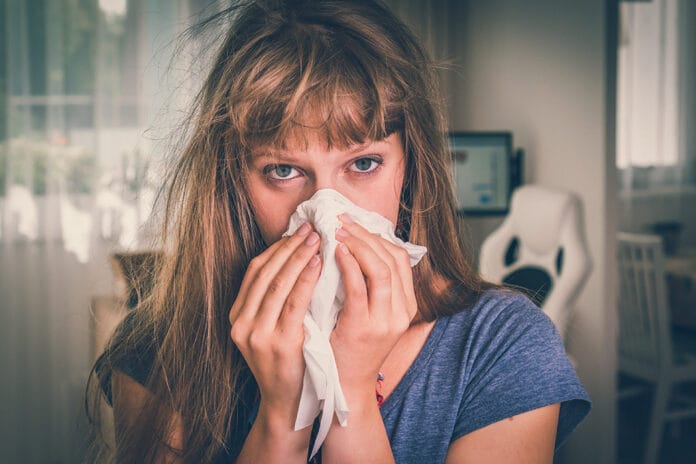It’s that time of year when patients and dental professionals are more vulnerable to getting sick from the seasonal flu or common cold. Many dental hygienists still go on with their day ─ even though they are not at their peak yet in recovery ─ and they do not feel bad enough to use a vacation day for being sick. To get through a “bug,” it’s common to take more cough drops and medicine to subdue cough symptoms and congestion.
Regarding dental health care professionals (DHCP) working while sick, the Centers for Disease Control and Prevention state, “DHCP are responsible for monitoring their own health status. DHCP who have acute or chronic medical conditions that render them susceptible to opportunistic infection should discuss with their personal physicians or other qualified authority whether the condition might affect their ability to safely perform their duties. However, under certain circumstances, health care facility managers might need to exclude DHCP from work or patient contact to prevent further transmission of infection. Decisions concerning work restrictions are based on the mode of transmission and the period of infectivity of the disease.”13 Simply put, it’s best for you, your co-workers, and those you treat to stay home if you are sick.
With flu and cold season, dental patients may complain of more teeth or mouth issues. This article reviews some of the oral health concerns below.
The Common Cold
A cold is from a virus in the upper respiratory system. It is called the “common” cold as it is the most infectious disease within humans. Caused by multiple viruses, symptoms range from mild to severe. Most common viruses embedded in the common cold are rhinoviruses, adenoviruses, enteroviruses, and coronaviruses.
Colds tend not to create serious health issues. Depending on medical vulnerabilities, though, a common cold can convert into serious complications. A cold will peak in three to five days after exposure and lasts around seven to 10 days, occurring mostly in the colder months of fall, winter, and spring.
As the body tries to battle a cold, the immune system kicks into action by causing symptoms of a headache, runny nose, sneezing, a sore and scratchy throat, cough, and, more rarely, a fever that is typically low grade.1
Viruses within a Cold
There are many types of viruses and strains, and, within each virus, there are subtypes, which are considered DNA or RNA coded. DNA viruses are when the virus replication happens in the nucleus of the cell, while RNA viruses are when the virus replication transpires in the cytoplasm.
Viruses are considered enveloped or nonenveloped. An enveloped virus has a lipid membrane surrounding the capsid (the protein shell enclosing the genetic products), preventing the virus from breaking down the host cell’s membrane. When they enter the host, they attack the immune system. When the cell weakens or dies, it sheds the viral particles into the body, potentially causing persistent infections that survive longer with higher adaptability.
On the other hand, a nonenveloped virus is without the outer covering of the capsid, making it more virulent and able to break down the host’s cells membrane. They have less resistance and adaptability with shorter survivability and do not cause chronic infections. Viruses need the body’s cells to live and replicate, as they can’t replicate on their own. Viruses are reduced through antiviral medications or vaccines.2
Rhinoviruses ─ Rhino “nose” virus is usually where it affects and is entered through the nose, mouth, and eyes. It is a smaller size virus of 30 nanometers and is a nonenveloped RNA genome. The rhinovirus is the most common viral infection in humans and is most predominant for the cold.
Rhinoviruses are spread from person to person through breathing the air, close proximity of a contagious person, and/or touching something with the rhinovirus on it and then touching the face. This virus initially enters the upper respiratory system and attaches to an intercellular adhesion receptor molecule in the back of the nasal cavity.
When it affects the epithelial cells in the nose, the membranes swell, initiating the immune system defense. The body goes into full defense mode to fight off the virus by swelling the nose and soreness of the throat. The increased mucus causes a runny nose and other symptoms of sneezing, coughing, fatigue, and fever kicking in to protect the body. If the body has had this virus before, the initial attack of the white blood cells will be sufficient.
The rhinovirus is detected in the body about 24 hours after entry and is at its highest within 48 to 72 hours. This cold will start to ease up within five to seven days, with a cough likely to last for a few weeks.
Symptoms include earaches, sinusitis, bronchitis, congestion, sneezing, headache, sore throat, fatigue, muscle ache, facial and ear pressure, cough, loss of sense of smell and taste, and vomiting.
Treatment is focused on the symptoms with rest, hydration, decongestants and antihistamines, or antiviral medications as no vaccines are available.
Adenoviruses ─ The adenovirus received its name by originally affecting the adenoids. There are many types of adenoviruses with several serotypes. It is a medium-sized virus, 90 to 100 nanometers, and is a nonenveloped DNA genome. The serotype depends on the symptoms and main location it affects, such as respiratory, conjunctivitis, and gastrointestinal.
This cold virus can range from mild cold symptoms to life-threatening multi-organ issues (mainly with people who are immunocompromised). The virus is most contagious in the first two days, with respiratory symptoms appearing two to 14 days after exposure and intestinal tract infections appearing three to 10 days after exposure.4
Transmission is from an infected person by coughing, sneezing, close contact, and touching a contaminated object before touching the face. It also can be contacted through stools such as when changing a diaper, swimming pools, towels, faucet handles, or someone not washing their hands and preparing food. It spreads quickly among children who share toys.
The symptoms include fever, sore throat, pneumonia, conjunctivitis, acute bronchitis, acute gastroenteritis, bladder and bowel infections, croup, and meningitis.
As most people recover on their own, treatment focuses on the symptoms with rest, hydration, decongestants and antihistamines, and over-the-counter cold medications, as there are no proven medications for this virus. There are no vaccines, but modified adenovirus vectors are used for other vaccines.5
Enteroviruses ─ Enteroviruses (“enteric,” meaning intestinal) is a nonenveloped RNA strand. It contains many serotypes, with the most infected type in humans being non-polio. It is one of the smallest viruses at 27 nanometers. This is the virus that can cause polio as well as hand, foot, and mouth disease. The transmission route is intestinal through feces, blister fluid, or mouth, nose, and eye secretions.
Enteroviruses circulate every year with an emphasis on summer and fall seasons, affecting infants, children, and teenagers more than adults.
The symptoms include common cold symptoms, mouth blisters, skin rash, and body aches. The more intense symptoms are hypoxia, meningitis, encephalitis, conjunctivitis, paralysis, hand, foot, and mouth disease, pericarditis, myocarditis, inflammatory muscle disease, and acute paralysis.
Treatment focuses on the symptoms, with rest, hydration, and over-the-counter cold medications. For underlying health issues and immunocompromised patients, some cases may include hospitalization. No vaccine is available except for the polio vaccine.6
Coronavirus ─ Seasonal corona “crown” virus (named for the appearance of spikes resembling a crown) is an enveloped RNA genome virus and one of the largest RNA viruses ranging from 50 nm to 200 nm. They cause respiratory tract infections by mainly attaching to epithelial cells of the respiratory tract. It is mainly an upper respiratory illness but can cause lower respiratory issues with pneumonia and bronchitis ranging from mild to fatal.7
Seasonal coronavirus is more common in the fall and winter but can happen anytime. Transmission occurs through the air by coughing and sneezing, close contact, and touching a contaminated object before then touching the face.
The virus circulates every year and is at a higher risk in children, infants, older adults, as well as cardiopulmonary diseased and weakened immune system patients.
Symptoms include runny nose, sore throat, headache, cough, fever, and malaise.8 People tend to recover on their own with treatment being focused on the relief of symptoms with rest, hydration, and over-the-counter cold medications. No vaccine is available.
The Flu
Influenza viruses cause the flu, and influenza is a contagious respiratory illness that initially affects the upper respiratory epithelial cells (the throat, nose, and sometimes the lungs). Illnesses are more susceptible to progressing into pneumonia either by the primary viral infection or a secondary bacterial infection from Streptococcus pneumoniae or Staphylococcus aureus.
The H1N1 strain affects the upper respiratory tract and is mild but more transmissible. The H5N1strain affects the lower respiratory tract and is more severe and less contagious. Both can become mild to severe and even fatal.9
Influenza is an RNA genome virus and is 80 to 120 nanometers in size. Characterized as types A, B, C, and D, types A and B are common and infect the population yearly.10 Type A is found in humans, pigs, and birds, accounting for 75% of the seasonal flu through the subtypes of H and N. Type B is found in humans, accounting for 25% of the seasonal flu and has lineages of B. Type C is found in humans, dogs, and pigs, and type D is found in cattle.
Symptoms start one to four days after exposure, usually within two days, and last for about two to eight days. Influenza is transmitted through breathing, talking, coughing, and sneezing.
Symptoms include fever, aching muscles, chills and sweats, vomiting, diarrhea, fatigue, shortness of breath, headaches, runny nose and congestion, eye pain, sore throat, and a dry, persistent cough. Complications can occur with bacterial pneumonia, ear and/or sinus infections, meningitis, encephalitis, and worsening of pre-existing chronic medical conditions.
Influenza usually resolves on its own but can become severe or fatal in higher-risk individuals. High-risk categories include patients under five years old and older than 65, weakened immune systems, pregnant women, and assisted living residents. In addition, chronic medical conditions increase risk, and these conditions can include asthma, obesity, diabetes, and heart, kidney, and liver diseases.8
Treatment focuses on relief of symptoms with rest, hydration, over-the-counter cold medications, antiviral medications, and vaccines.
Sinus Infections
A sinus infection can be associated with or mistaken for a cold or flu. It is when fluid accumulates in the sinuses, causing pathogens to grow, and the sinus lining becomes inflamed, preventing drainage. It can be viral (more commonly), bacterial, or fungal. Sinus infections can derive on their own or from the result of a cold, allergies, nasal polyps, structural conditions of the nose, and immunodeficient conditions.11
Symptoms for sinus infections are:
- Viral symptoms ─ Swelling in the nose, facial pain and pressure, coughing, congestion, runny nose, fever, and sleep impairment
- Bacterial symptoms ─ Facial tenderness, fever, congestion, coughing, green nasal discharge, headaches, toothaches, and post-nasal drip
- Fungal symptoms ─ Fever, headaches, facial pain, inflammation of the sinuses, pressure in the nasal passages or head, congestion, coughing, and impaired eyesight
Sinus infections that last fewer than 10 days with symptoms improving are considered viral. If symptoms last more than 10 days or worsen, it’s most likely bacterial. Teeth pain and halitosis are indicative of a bacterial infection. Fungal infections are noninvasive and go away without serious complications, while invasive infections can spread to other parts of the body. Both classifications commonly appear in people with a weakened immune system.
When the four sinuses are congested and full, they add pressure to distinct parts of the head:
- Maxillary ─ Causes pressure in the cheek, resulting in pain like a headache and toothache
- Frontal ─ Causes pressure above the eyes, resulting in a headache mainly in the forehead
- Ethmoidal ─ Causes pressure between or behind the eyes, resulting in pain on the sides of the upper part of the nose and headaches.
- Sphenoidal ─ Causes pressure behind the eyes, resulting in pain in the back or top of the head.
Treatment may include decongestants, antibiotics, or corticosteroids.12 Although the flu, common cold, and sinus infections are different, they do share symptoms that can affect the oral cavity, including the following:
Tooth pain ─ Maxillary posterior teeth roots are just below the maxillary sinus cavity or, in many cases, they are well into the sinuses. When the sinuses are inflamed or congested, it has a direct impact on teeth. Mucus-filled and inflamed sinuses increase pressure on the roots of those maxillary teeth, which results in pain or sensitivity.
Sinus pain presents as a dull, continuous discomfort that is increased when moving the head or looking down. The discomfort is usually isolated to the maxillary posteriors and accompanied by other symptoms associated with sinuses.
Being aware of sinus-related tooth pain versus actual tooth pain can save a patient unnecessary treatment. An abscessed tooth, in comparison, increases and intensifies with pain to biting, chewing, and temperature, specifically with a single tooth.
Xerostomia ─ Dry mouth is common with colds. With a stuffy nose, survival skills take over to initiate mouth breathing as essential. Breathing through the mouth and coughing can cause dryness of the tissue, teeth, throat, and lips. Saliva is lacking for moistening the oral cavity and washing away bacteria and food regularly, and biofilm accumulation that causes decay and periodontal disease becomes prominent.
Halitosis ─ Bad breath may be the result of xerostomia or post-nasal drip. Excess mucus from a cold creates an enhanced habitat for bacteria to pool and multiply, emerging into an unpleasant odor and taste. Post-nasal drip can cause bacteria-rich mucus to pool in the back of the throat while also causing a white coating on the tongue increasing halitosis.
Ear infections ─ Ear infection pain can radiate into the jaw and teeth to cause referred pain.
Vomiting ─ Vomiting heaves the acid from the stomach into the mouth. With the teeth covered with acid, it increases decalcification which can lead to enamel erosion and dental decay. Vomit also leaves a bad taste and feel in the mouth, encouraging the instinct to want to brush right away, which can cause more wear, decalcification, and sensitivity.
Treatments and Oral Health Concerns
The importance of a robust immune system plays a significant role in the treatment plan. People who are vulnerable will have more severe symptoms, as well as longer duration and recovery when fighting the flu and cold. So they may be on medicines longer that can be harmful to the mouth.
Since the flu, colds, and sinus infections may have the same symptoms, at-home treatment is usually the same unless they become severe when professional medical treatment is highly advised. Over-the-counter products and remedies could be detrimental to the oral health environment.
Cough medicines ─ The use of cough syrup may increase dental problems since these medicines contain sugar and alcohol.
Cough drops and lozenges ─ These products are usually made with sugar, and sucking on them throughout the day for multiple minutes at a time can increase the risk of decay by prolonging an acidic environment, especially when home care is poor.
Decongestants ─ The function of decongestants is to dry up mucus production. While drying up the sinuses, it can also dry up the mouth and promote biofilm adhesion.
Sugar consumption ─ Congestion affects smell and taste, and it makes eating unpleasant. Under these conditions, higher consumption of sugar may happen, leading to higher risks of decay. Juices, especially orange juice, may be consumed to acquire more vitamin C. Juice is acidic and sugary and can lead to decalcification. If a sore throat is present, softer foods are more agreeable, and foods with higher sugar content such as pudding, ice cream, milkshakes, popsicles, Jell-o, ginger ale, and Sprite may be consumed to soothe the aggravating heat in the throat.
When sick, oral home care usually slides down on the list of daily tasks. Taste is gone, appetite is gone, energy is gone, and so is desire. The concentration is just to relieve the headache, fever, or congestion along with getting enough sleep.
Of course, staying hydrated not only helps the body, it helps orally as well. Advising patients to brush and clean interdentally well while they are sick as they may accumulate more biofilm from an unfamiliar dry mouth. Recommend taking medicine in a pill form rather than a liquid form or consuming medications with food to neutralize the effect of xerostomia. Using sugar-free cough drops will instigate saliva production and prevent any negative results with the teeth. After vomiting, advise rinsing with water or nonalcohol mouthwash instead of brushing immediately to prevent enamel damage. Waiting to brush for at least 20-30 minutes should be encouraged.
In the end, the goal is to overcome the sickness systemically and orally, and reminding patients about possible oral effects will benefit them in the long run.
Before you leave, check out the Today’s RDH self-study CE courses. All courses are peer-reviewed and non-sponsored to focus solely on high-quality education. Click here now.
Listen to the Today’s RDH Dental Hygiene Podcast Below:
References
- Paddock, M. (2020 December 4). All about the Common Cold. Medical News Today. https://www.medicalnewstoday.com/articles/166606
- Baron, S. (Ed). (1996). Structure and Classification of Viruses. In H.R. Gelderblom (Ed.), Medical Microbiology (4th ed., Ch. 41). University of Texas Medical Branch at Galveston. https://www.ncbi.nlm.nih.gov/books/NBK8174/
- Bowne, C. (n.d.) Rhinoviruses: How it Infects Humans. Penn State University. http://sites.psu.edu/coreybowneportfolio/wp-content/uploads/sites/36775/2015/12/Rhinovirus.pdf
- Double-stranded DNA Viruses-Adenoviruses. (2021, January 3). Biology Libre Texts. https://bio.libretexts.org/Bookshelves/Microbiology/Book%3A_Microbiology_(Boundless)/9%3A_Viruses/9._11%3A_DNA_Viruses_in_Eukaryotes/9.11H%3A_Double-Stranded_DNA_Viruses-_Adenoviruses
- Cohen, J. (2020, October 19). Could Certain COVID-19 Vaccines Leave People More Vulnerable to the AIDS Virus? https://www.science.org/content/article/could-certain-covid-19-vaccines-leave-people-more-vulnerable-aids-virus
- Non-polio Enterovirus. (2020, August 8). Centers for Disease Control and Prevention. https://www.cdc.gov/non-polio-enterovirus/about/symptoms.html
- Masters, P.S. The Molecular Biology of Coronaviruses. Adv Virus Res. 2006; 66: 193-292. https://www.ncbi.nlm.nih.gov/pmc/articles/PMC7112330/
- Common Human Coronavirus. (2020, February 13). Centers for Disease Control and Prevention. https://www.cdc.gov/coronavirus/general-information.html
- Cold Versus Flu. (2022, September 29). Centers for Disease Control and Prevention. Retrieved from https://www.cdc.gov/flu/symptoms/coldflu.htm
- Types of Influenza Viruses. (2023, March 30). Centers for Disease Control and Prevention. https://www.cdc.gov/flu/about/viruses/types.htm
- Sinus Infection (Sinusitis). (2019, August 27). Centers for Disease Control and Prevention. https://www.cdc.gov/antibiotic-use/sinus-infection.html
- How to Tell if Your Cold is Actually a Sinus Infection. (2020, October 1). Cleveland Clinic. https://health.clevelandclinic.org/cold-really-sinus-infection-tell/
- Kohn, W.G., Collins, A.S., Cleveland, J.L., et al. Guidelines for Infection Control in Dental Health-care Settings – 2003 [MMWR Report No. 17]. Centers for Disease Control and Prevention. 2003; 52: No. RR-17. http://www.cdc.gov/mmwr/PDF/rr/rr5217.pdf











